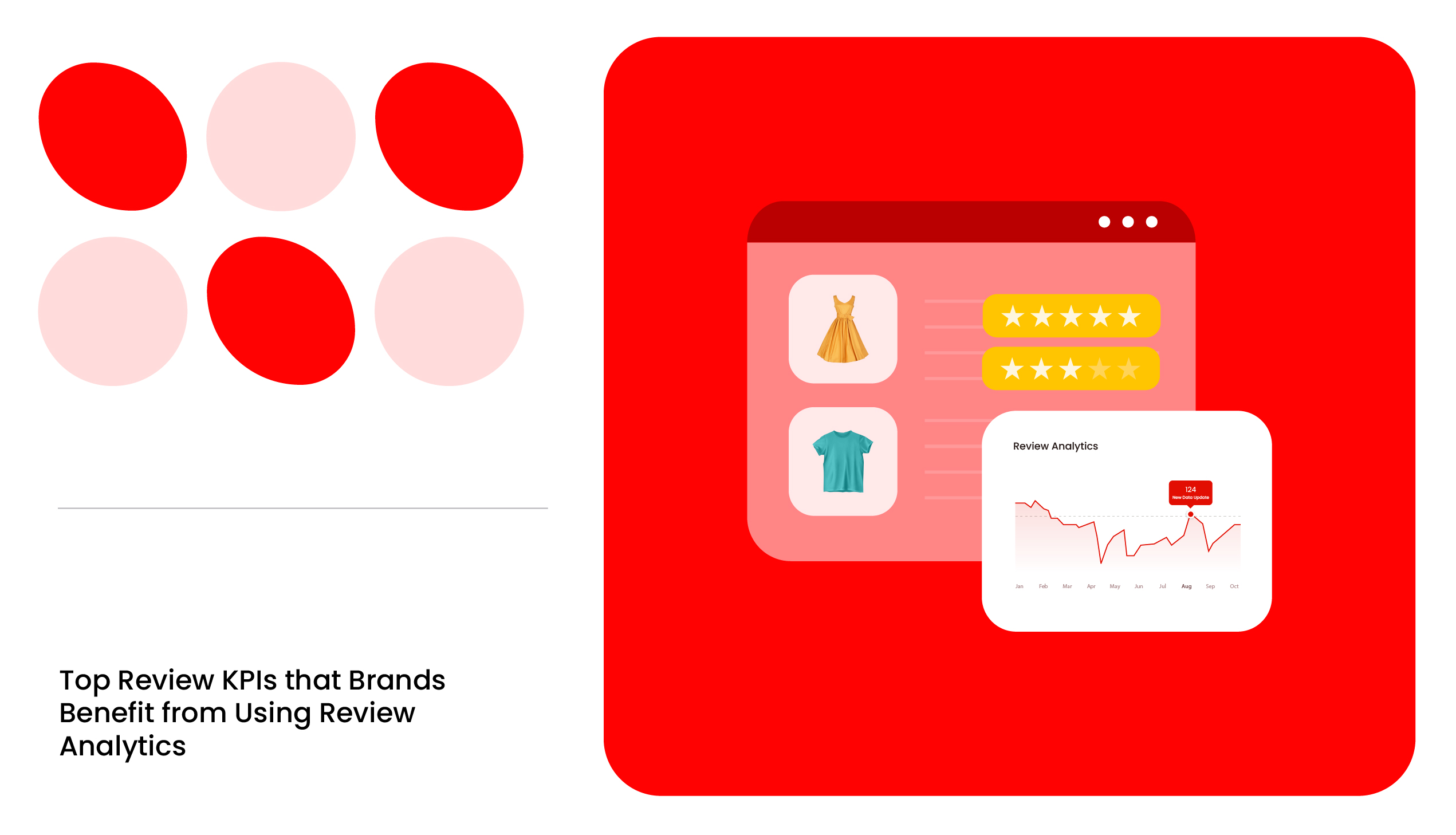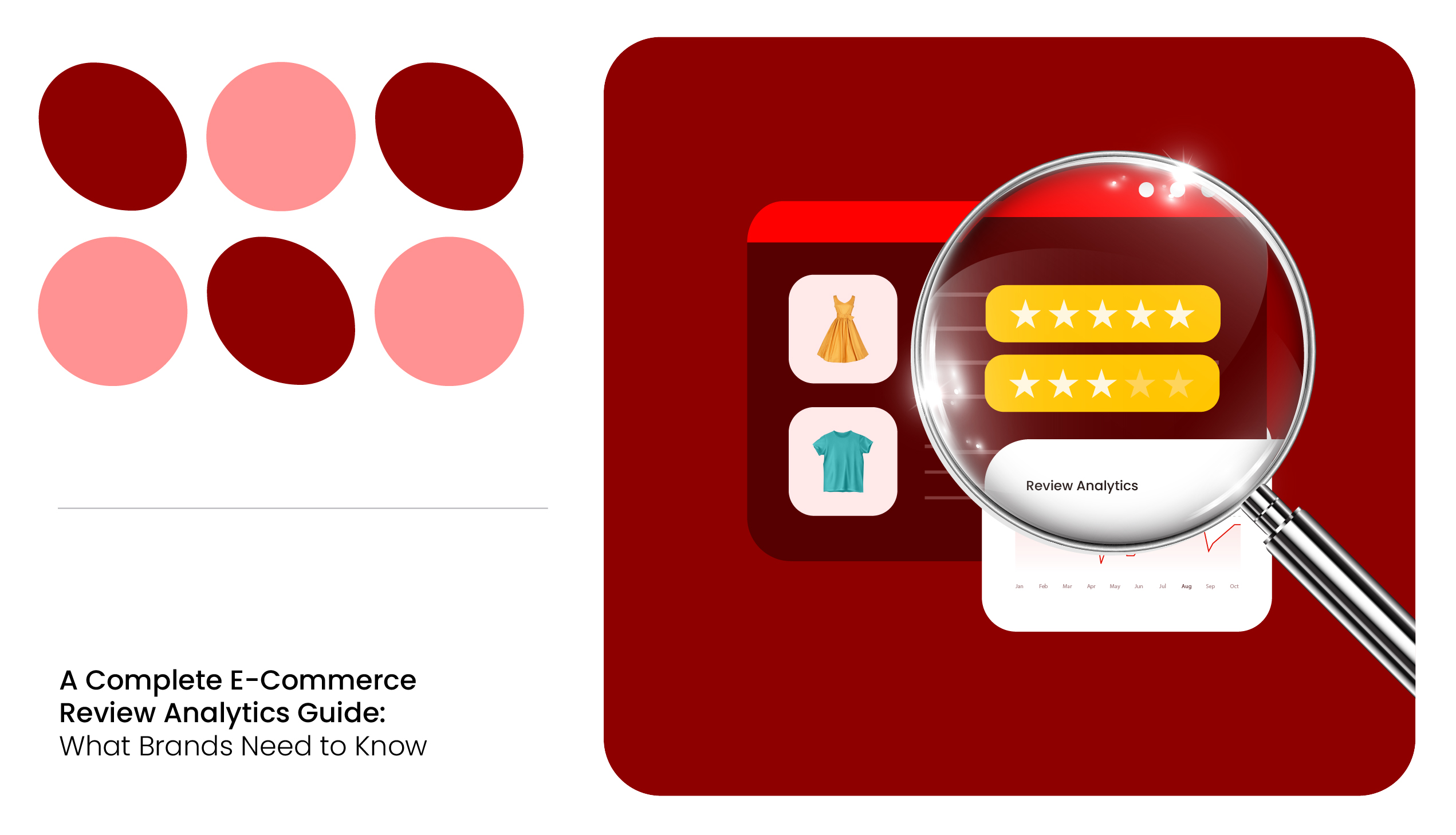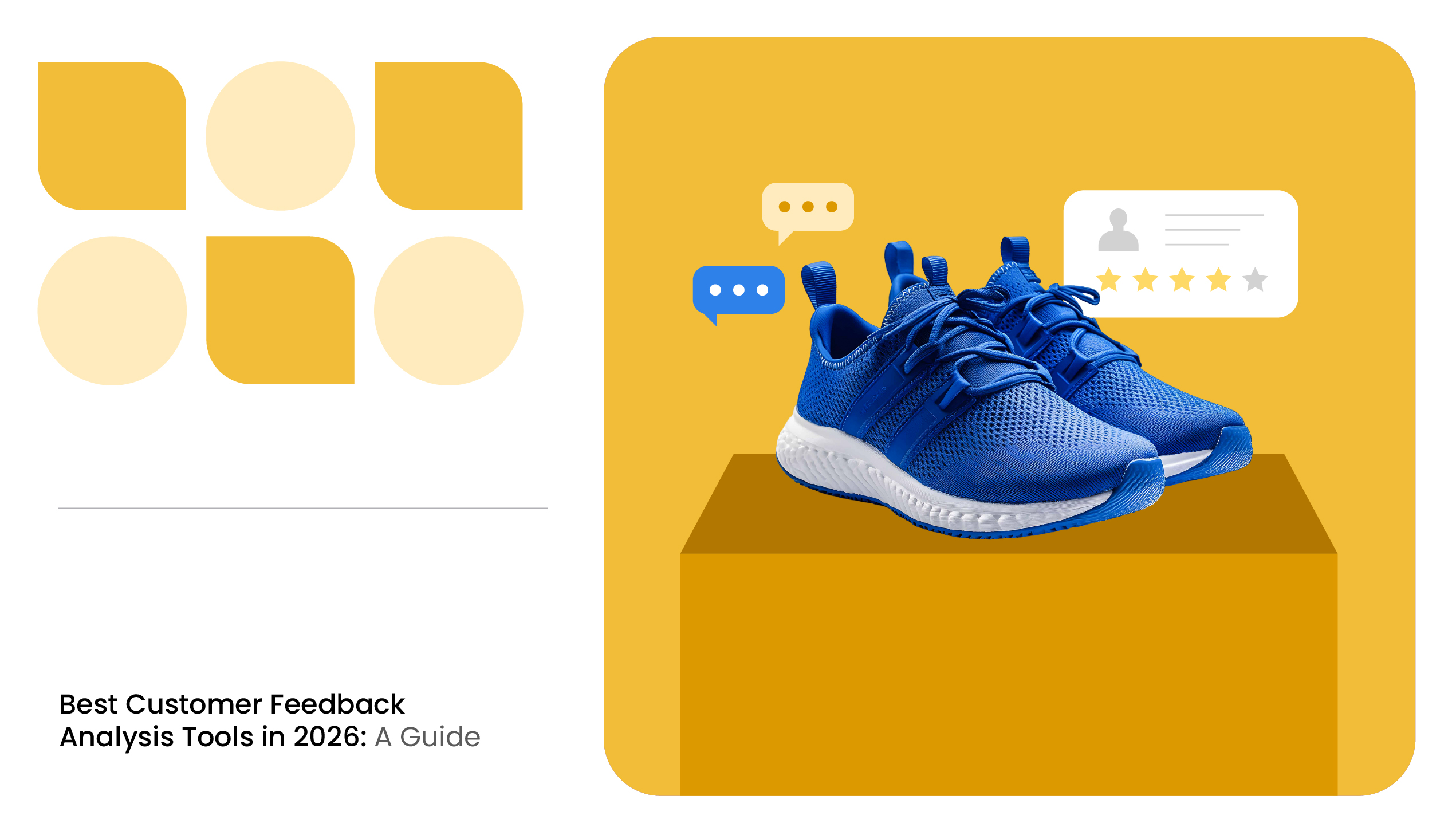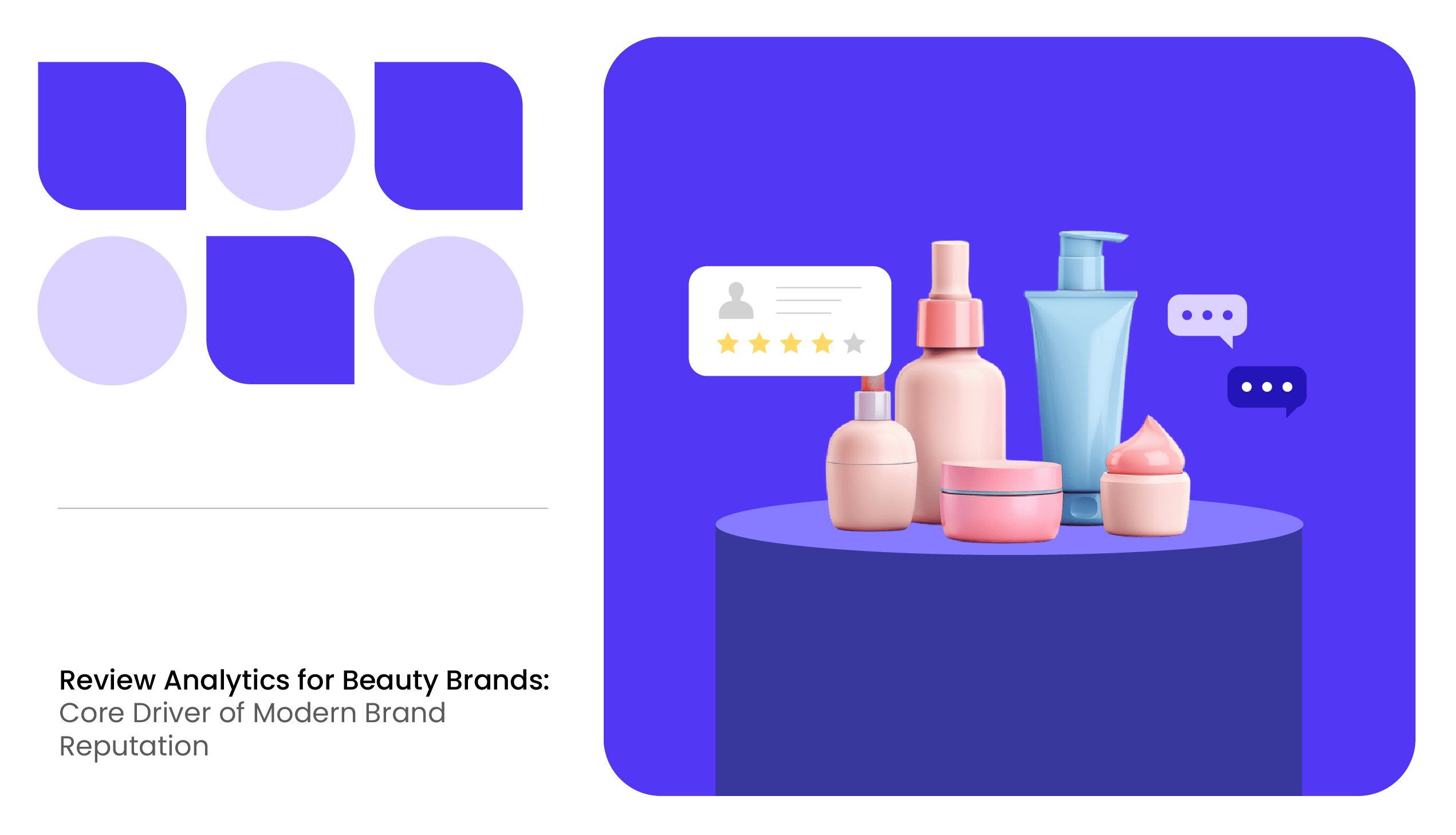With the popularity of social media and e-commerce, the importance of rating and review monitoring has progressed. For brands, these reviews are valuable data points that reflect customer sentiment, product performance, and overall brand reputation.
By tracking key review metrics, businesses can identify trends, detect potential issues early, and measure the real impact of customer feedback. MetricsCart’s review monitoring platform enables brands to bring all this information together in one place, offering clear insights that turn everyday reviews into actionable business intelligence.
11 E-Commerce Review Metrics Prioritized by Customer Feedback Analysts
The objective of the review metrics is to optimize the accumulation of customer feedback on e-commerce. The number of review KPIs can vary depending on the specific goals and processes of the review strategy.
Here are the 11 review KPI often used to evaluate the effectiveness and quality of reviews:
- Review Trends
- Reviews by Source
- Review Rating Distribution
- Review Length
- Review Coverage
- Review Volume
- Review Velocity
- Review Recency
- Review Authenticity
- Reviews by Incentives
- Net Promotor Score
Review Trends
Review trend monitoring allows businesses to stay proactive in brand reputation management. The review trends metric measures the change in patterns observed in the average star rating, the number of reviews, and the length of the reviews collected over time.
Having an overview of review trends allows brands to:
- Spot potential problems or opportunities early
- Address negative reviews promptly
- Gauge customer interest and satisfaction over time
For instance, if a product’s star rating decreases, reading the reviews can help brands pinpoint the cause for the same. Similarly, during slack periods when there is low review activity, brands can run campaigns to stimulate customer engagement.
READ MORE | Want to Know Why Online Customer Review Monitoring Matters in E-Commerce? Explore our article Product Rating and Review Monitoring on the Digital Shelf.
Reviews by Source
A brand gets customer reviews on its website, third-party review sites, e-commerce sites, and social media. Most of the products sold online are available in more than one marketplace.
Integrating these reviews from different marketplaces helps brands understand where customers prefer to shop and share feedback. Having all the reviews on a single customized dashboard, as provided by MetricsCart, makes monitoring easy for brands.
MetricsCart’s review monitoring service tracks:
- Total count of positive, neutral, and negative reviews
- Identify channels that generate the most reviews
- Top-performing sellers of each marketplace
- The count of reviews of bestselling products in each marketplace
Additionally, our review analysis solution further breaks down reviews based on product attributes. For instance, if a pet brand was most reviewed for its taste, the theme is further classified into sub-themes like chewiness and texture, and a percentage split is presented.
With these analytics, brands get an overview of the voice of the customer data across e-commerce channels and focus on ways to improve the review count in underperforming channels.
READ MORE | Want to get a glimpse of MetricsCart’s review analytics on e-commerce channels? Here is a report on Understanding the Consumer Behavior at Walmart: Expectations and Implementations
Review Rating Distribution
The review rating distribution metric is a measure used in e-commerce customer review analysis. This metric is also crucial for understanding specific areas where customers may be particularly happy or unhappy, which can be valuable for making informed business decisions.
Heat maps and bar charts are visualization methods used to receive patterns in the distribution of review ratings (from 1-star to 5-star).
Some of the advantages of this metric are:
- Brands can compare with competitors to see if the distribution of ratings aligns with industry standards.
- Analyze if there is a correlation between categories and their ratings.
- Receive actionable insights to investigate potential issues for low and neutral ratings.
- Product features with positive reviews can be replicated in other products.
- It gives businesses a clear picture of customer satisfaction and helps them understand the overall customer sentiment over time.
READ MORE | Why is it necessary to monitor ratings and reviews on the digital shelf? Here is a Complete Guide to Ratings and Reviews in E-Commerce.
Review Length
Review length as a metric refers to measuring the length of customer reviews, typically in terms of the number of words or characters. This metric can provide insights into the depth and quality of customer feedback, which can be valuable for both businesses and consumers.
Potential consumers prefer lengthier reviews with detailed information. Usually, customers who have extreme experiences (either very positive or very negative) may write longer reviews to express their detailed thoughts and emotions.
Critical aspects of review length as a metric for businesses are as follows:
- Longer reviews are typically referred to as actionable feedback, as they have in-depth details and have a better conversion rate.
- Detailed feedback includes more keywords, giving the listing an SEO boost.
- Review length helps businesses gauge consumer behavior. For example, concise reviews indicate that the product meets basic expectations but does not exceed them in a way that inspires detailed feedback.
One of the features of MetricsCart review analysis is sentiment analysis to spot in-depth themes and sub-themes.
Review Coverage
Review coverage helps businesses understand how well customer feedback represents their entire product portfolio. It refers to the total number or the percentage of reviews that the brand has received in comparison to other brands in a specific category.
The benefits of the review coverage metrics are:
- Companies can use review coverage as a benchmarking tool against competitors.
- High customer engagement is equivalent to high review coverage. Low review coverage means that only certain products or services are being reviewed. It suggests that customers lack interest in the product or that there are issues in product discovery. To encourage customers to leave reviews, additional marketing or better product descriptions might be required.
- Analyzing review coverage helps businesses understand why certain products lack customer feedback.
According to a January 2023 Local Consumer Review survey, over 43% of respondents said they regularly read online reviews of local businesses. Only 2% responded that they never read online reviews.
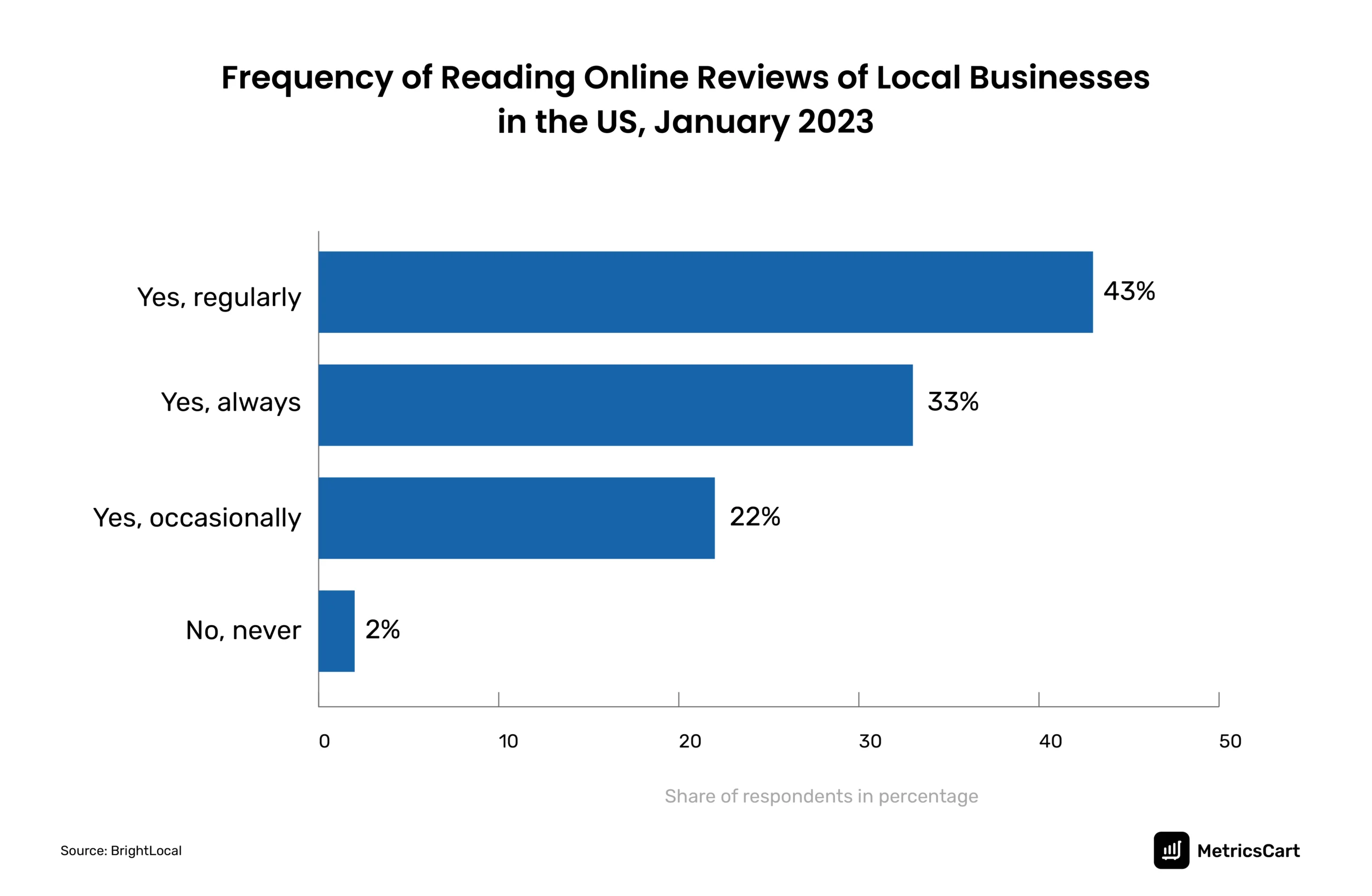
These statistics suggest that companies must ensure that all their product listings have at least a few reviews, as there is a direct relation between the number of reviews a product receives and the sales conversion.
Review analytics can reveal products with below-average review coverage. To boost review numbers, sellers can contact customers within 21 days of buying the product for a post-purchase review.
Review Volume
The review volume metric shows the total number of reviews collected over a specific period. A high review volume indicates increased engagement and builds trust among potential customers.
Advantages of monitoring and analyzing review volumes:
- Comparing review count with competitors reveals the market position and reputation among customers.
- A high volume of reviews can significantly boost a product’s credibility compared to competitors.
- A large volume of reviews provides a wealth of data that can be analyzed to make informed business decisions.
- Review volume can positively impact a product’s visibility on search engines and e-commerce platforms.
- Algorithms often prioritize products with more reviews, which can lead to higher rankings in search results and increased organic traffic.
- A high review volume provides a broader and more diverse set of feedback that can be used to meet customer needs better.
- Large volumes of reviews make it easier to detect trends in customer satisfaction or dissatisfaction.
Leveraging the advantages of review volume can be a powerful strategy for boosting product performance, enhancing customer satisfaction, and driving business growth.
READ MORE | How can Brands Improve the Customer Buying Process? Optimizing Consumer Buying Process: What Every E-Commerce Brand Needs to Know
Review Velocity
The review velocity metric shows the number of new reviews added to the listing. A consistent flow of reviews indicates ongoing customer engagement. Review velocity refers to the speed or rate at which a product receives new reviews over time.
Here are the strategic advantages of monitoring and optimizing review velocity in e-commerce:
- A high review velocity often signals a growing customer base and rising interest in the product, which can attract more potential buyers.
- Review velocity boosts product rankings. A steady influx of new reviews can help maintain or improve a product’s position in search results, leading to greater visibility and potentially higher sales.
- For new product launches, achieving a high review velocity can quickly create buzz around the product and build customer trust.
- Consistent reviews enhance conversion rates.
- A higher review velocity compared to competitors can be a differentiator that signals superior product quality.
- A high review velocity can create a positive feedback loop. The product’s visibility and credibility attract more buyers, who in turn leave more reviews, further enhancing the product’s appeal and ranking.
By understanding and leveraging review velocity, businesses can better manage their product’s reputation, optimize marketing efforts, and sustain growth in a competitive environment.
Review Recency
Review recency refers to how recent the reviews of a product or service are, meaning the time that has elapsed since the reviews were posted. Maintaining review recency ensures that the feedback is relevant, up-to-date, and reflective of the product’s current state. This is critical for building and maintaining consumer trust, improving search rankings, and driving sales.
One of the findings from the ‘Power of Review Volume & Recency’ survey is that consumers from the older generation are more likely to value the review recency metric over review volume.
Here are the advantages of maintaining review recency:
- Review recency can enhance conversion rates as consumers are more likely to trust and rely on recent reviews than older ones.
- E-commerce platforms and search engines often prioritize products with recent reviews. Review recency can improve a product’s ranking in search results, making it more visible to potential buyers. This can lead to increased traffic and higher sales.
- If a product or service undergoes significant changes, such as new features or updates, recent reviews will reflect these updates, helping potential customers understand the current state of the offering. This is especially important if older reviews cite issues with specific features.
- Recent positive reviews can mitigate negative perceptions about a product and enhance its reputation management.
E-mail follow-up is the top organic review collection method brands use to meet the consumer expectation of featuring the latest reviews on a product page when shopping online.
Review Authenticity
Review authenticity refers to the genuineness of reviews provided by customers about a product. Ensuring the authenticity of reviews is crucial for businesses, platforms, and consumers alike.
Reviews from credible, verified customers are often more trusted. Reviewers’ social proof and the use of natural language ensure that reviews are genuine and not manipulated.
Many platforms label reviews as “verified purchase” to indicate that the reviewer actually bought the product from the platform. While not foolproof, these reviews are more likely to be authentic.
Fake reviews may contain overly promotional language that sentiment analysis can help identify.
Reviews by Incentives
Most consumers need incentives like discounts, loyalty points, or a free product to feel motivated to write a review.
This metric refers to a strategy for encouraging customers to leave reviews in exchange for loyalty points, store discounts, or free samples.
The Amazon Vine program is an example of a review-by-incentive program in which Amazon-appointed reviewers post detailed reviews about a product after using it for free.
Tracking the success of different incentive campaigns can help determine which type of incentive program is most persuasive to a particular customer group. Brands can then consider implementing the same program consistently throughout the year.
Net Promoter Score (NPS)
The Net Promoter Score (NPS) is one of the metrics used for measuring customer loyalty and satisfaction. It reflects how likely customers are to recommend a brand or product to others, based on their overall experience.
In e-commerce review analytics, NPS acts as a key indicator of customer advocacy and retention. Customers are typically categorized as:
- Promoters (score 9–10): Highly satisfied customers who actively recommend the brand.
- Passives (score 7–8): Neutral customers who are satisfied but not enthusiastic enough to promote.
- Detractors (score 0–6): Dissatisfied customers who may discourage others from buying.
Integrating NPS with review analytics helps brands connect emotional satisfaction with tangible business growth, transforming feedback into a long-term retention strategy.
Which is the Best Review Analytics Platform?
Customer feedback holds the power to shape brand perception, influence purchase decisions, and drive sustained growth. Analyzing review KPIs such as review trends, velocity, authenticity, and Net Promoter Score enables businesses to act with precision and foresight.
If your business aims to create a holistic review monitoring strategy and wishes to maximize the benefits of customer feedback in driving e-commerce success, MetricsCart can offer one of the best review analytics services. You may contact us to receive a customized review analysis package to suit our needs.
Convert Customer Feedback into Actionable Insights with MetricsCart.

